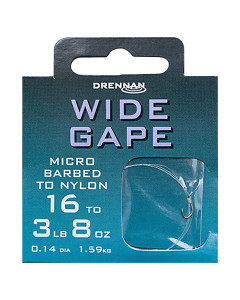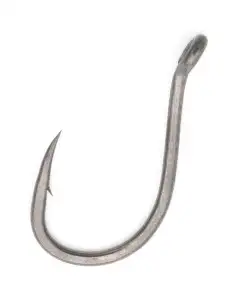This is a demo store. No orders will be fulfilled.
Choosing a Fishing Hook: Different Types and Their Use

Hooks are an indispensable component of any angler's arsenal. This piece of terminal tackle is essential for securing bait and luring fish, and the right hook can mean the difference between a successful catch and a frustrating day on the water.
Despite their importance, hooks are often overlooked by novice anglers, who may not realise the subtle differences between hook types and their various applications. At Angling Direct, we understand the significance of selecting the proper hook for your fishing style and the species you're targeting.
Our goal is to provide you with expert guidance in choosing the right hook, ultimately increasing your chances of reeling in more fish, achieving your angling goals and most importantly, minimising harm to the fish we catch.
What is a fishing hook called?
A fish hook (previously called an angle) is a tool used to catch fish. It involves piercing and embedding the hook inside the fish's mouth so that it can be reeled in and netted.
What are the components of a fish hook?


Point: the sharp end that first contacts the fish's mouth. Keep it sharp for better results.
Bend: the curved part that includes the throat and gape. The throat is the depth of penetration, and the gape is the width from point to shank.
Shank: connects the bend to the eye and can be short or long.
Eye: the loop for the fishing line, which can be turned up, down, or straight.
Gauge: the wire diameter. Heavier-gauge hooks resist bending, while smaller-gauge hooks are lighter and easier to hide.
Gape: the distance between the point and the shank. The wider it is, the better chance of catching the fish as it expels the bait.
Which Hooks Are Best for Fishing?
Different fishing hooks have varying features, such as wide gaps or barbs, to prevent losing bait. Angling Direct offers various hook styles to cater to your fishing needs.


Circle Hook
They are circular in shape and are popular due to their excellent hook-hold. Well-suited for catch-and-release, method work, and live bait fishing, you can also use circle hooks for pike fishing. Designed to attach to the corner of the fish's mouth. Apply steady pressure and reel in firmly when using a circle hook.


Wide Gape Hook
Wide-gape hooks are commonly used for carp and other specimen fish due to their strength and hooking properties. They are ideal for larger fish and feature a wider gap between the shank and point, allowing for increased pressure and a stronger hook-hold.


Aberdeen Hook
Commonly used in sea fishing, features light wire and a thin diameter for easy bait hooking with minimal damage. They work well for freshwater fishing too, allowing live bait to stay lively. If snagged, they can be easily bent and pulled free with some pressure.


Long Shank Hook
One of the best hooks for carp fishing. Perfect for use with bottom baits, long-shank hooks are useful for smaller hooks as they provide a larger surface to grip when removing them. Carp anglers have recently employed long-shank hooks for specialised rigs that apply more pressure to the hook-hold, particularly when the shank is bent inwards.


Curve Shank Hook
Curved Shank hooks were initially more common in fly fishing, while carp fishing hooks featured a straight shank design. However, carp anglers have since discovered the benefits of curved shank hooks, which make it harder for fish to dislodge once they've taken the bait.


Stiff Rigger Hooks
Stiff Rigger hooks work well with fluorocarbon or monofilament hooklinks, making them a popular choice as fishing carp hooks. They are ideal for chod rigs, as they prevent the weakening of materials when tied to an in-turned eye hook with a knotless knot.


Chod Hooks
Chod hooks feature an out-turned eye for optimal presentation of pop-up baits, resulting in excellent hook holds on captured fish. They are commonly used in rigs that incorporate buoyant bait, such as Chod and Zig rigs.


Treble Hook
This hook type has 3 points on a single shaft to maximize the chances of catching a fish. Treble hooks provide better coverage on lures, making them ideal for crankbaits, jerkbaits, and topwater baits as they offer superior hook-hold. However, note that double or treble hooks may differ in size compared to single hooks.
Hopefully, this will help you better understand the different types of hooks available and choose the one that best suits your fishing technique and needs.
How do I choose a hook?
Choosing the right hook depends on several factors, including the type of fish you want to catch and the fishing technique you use.
Fishing Hook Sizes: If you're looking to catch bigger fish, it's best to use a bigger, stronger hook. Smaller hooks are also more suitable for fish that have smaller mouths.
Hook Strength: A hook's strength is determined by its wire gauge - heavy, medium, or light. Fine gauge hooks (sizes 26-20) are for smaller fish, with a thinner wire allowing for a better presentation and easier penetration. Medium-gauge hooks (sizes 18-12) provide more strength for bigger fish and larger baits without affecting presentation. Heavy gauge hooks (sizes 10-2) are used for big specimens that require maximum strength.
Hook Eye or Spade: This refers to the area where the hook attaches to your line. Spade hooks have a flat section for tying the line around the shank, making them great for small hooks and presentation.
Hook Material: Fishing hooks are made from heavy metals or light wire, depending on the targeted fish. Angling Direct sells hooks made from pure iron or stainless steel, the latter of which doesn't rust but can harm the fish if left in their mouth.
Expert Tip: Always pack a disgorger and remove stainless steel hooks to prevent damage to the fish's throat. Freshwater and saltwater hooks may differ, as the latter can erode and rust metal more quickly.
What Are Hook Sizes?
We know that the sizes of fish hooks can be confusing. That's why we're breaking it down for you in this guide.
- The hook size is based on the gap between the shank and shaft (the gape) and the shaft length, given as a number.
- Generally, the bigger the number, the smaller the hook. For example, a #22 hook is tiny, while a #6 is big (great for bream)! Keep in mind that sizes can vary between brands.
- Aughts are fractions used for sea fishing hook sizes (e.g. 2/0).
- Hooks with an x have a shaft longer or shorter than the standard measurement.
- Choose the right size for your targeted fish to prevent gut-hooking.
- Consider the bait and presentation, whether on- or off-hook.


What are the Safest Hooks for Fish?


Barbed fish hooks have an extra point that allows them to penetrate a fish's mouth, making it harder for the fish to eject. While concerns about the damage caused to the fish's mouth exist, many anglers prefer barbed hooks for their superior hold.
However, many fisheries only allow barbless fishing hooks for fish safety. A micro-barbed hook provides a compromise, featuring a smaller barb that is easier to remove after catching the fish but still offers a better hook-hold than a barbless hook.
Expert Tip: You can flatten the barb of a barbed hook with pliers to make it barbless.
Tips for Proper Fishing Hook Maintenance
To ensure your hooks remain in top condition, follow these maintenance tips:
Cleaning and drying: After each fishing trip, clean your hooks with fresh water and dry them thoroughly to prevent rust.
Sharpening: Regularly check your hooks for sharpness, and use a hook sharpener kit or file to maintain their edge along with a small clamp.
Storing: Keep your hooks organised and protected in a tackle box or hook box to avoid damage and tangles.
How do you sharpen a hook?
How do you tie a hook on a fishing line for beginners?
Here are the basic steps for tying a simple fishing hook knot:
1. First, thread the fishing line through the eye of the hook. Make sure to leave a few inches of line on the tag end.
2. Take the tag end of the line and wrap it around the main line 4-6 times.
3. Next, take the tag end of the line and thread it back through the loop that was created when you wrapped it around the main line.
4. Moisten the knot with saliva or water and then gently pull on the main line to tighten the knot.
5. Once the knot is tight, clip the tag end of the line with a pair of fishing line scissors, leaving a small amount of line.


There are different knots that can be used to tie a hook to a fishing line, but this is a basic and commonly used one. Here are some popular knots and rigs to consider:
Grinner knot: Good breaking strength and easy to make
Palomar knot: Good breaking strength and keeps the hook in a straight position
Knotless knot: Easy to perform and allows freedom of movement for the hook
Blood knot: Good breaking strength and can be used to attach hook to fishing line


In summary, selecting the right fishing hook is crucial for a successful angling experience. By understanding the different hook types, their applications, and considering factors like target species, bait size, and fishing technique, you'll be well on your way to finding the perfect hook for your needs.
Remember that experimentation is key – don't be afraid to try different hooks and refine your choices based on your experiences. With the right hook in your tackle box, you'll be one step closer to landing that catch of a lifetime. Happy angling!
FAQs on Fishing Hooks
What are the most common types of hooks?
The most common types include the Circle hook, wide gape hook and the Stiff Rigger hook.
What are the strongest hooks?
Brands like Drennan, Korda, and Preston pride themselves on the strength and sharpness of their hooks, as well as offering a range of sizes and barbed/barbless options.
What is the best fishing hook length?
A good starting point for tying your own fishing hooks is a 12-inch hook length. You can also shop for fishing hooks to nylon with lengths already attached.
What is the most used hook size?
Size 2 circle hooks for carp fishing are a best-seller!
Why are fishing hooks so sharp?
Sharp hooks are more effective in catching fish than dull hooks. They penetrate hard fish mouths better and provide a greater margin for error in case of poor hook sets.
What is the best fishing hook for beginners?
Circle hooks are a fantastic choice for novice anglers. Simply begin reeling in your line, and the fish will hook itself in the corner of its mouth. This makes for an easy removal process and a more enjoyable fishing experience overall.


















